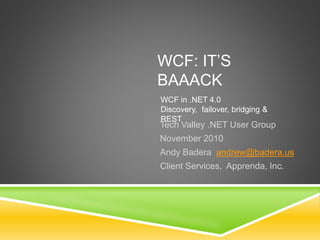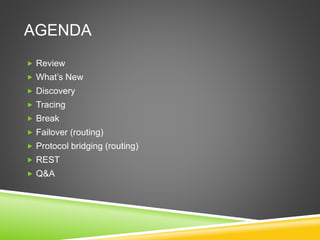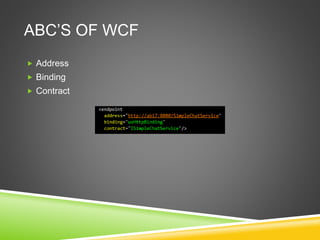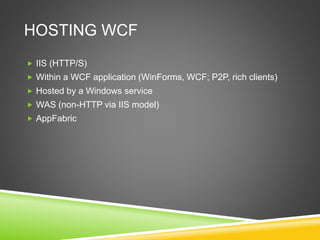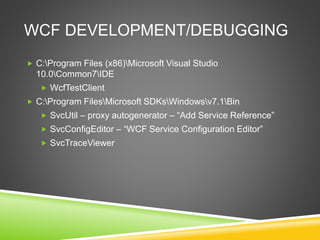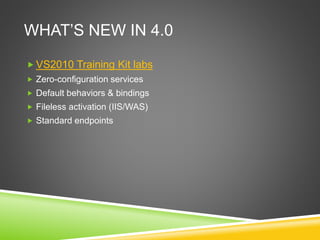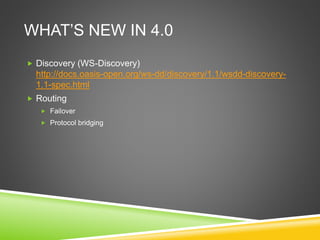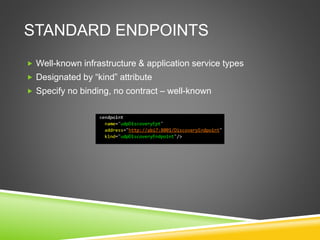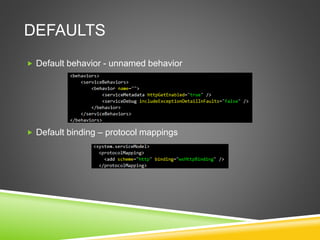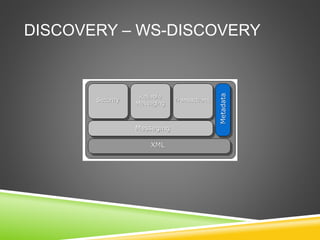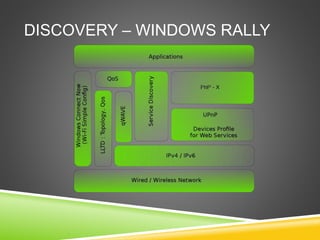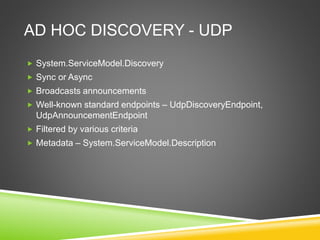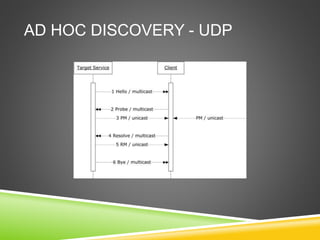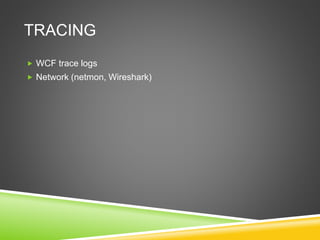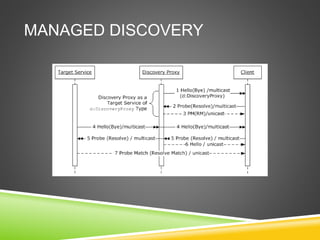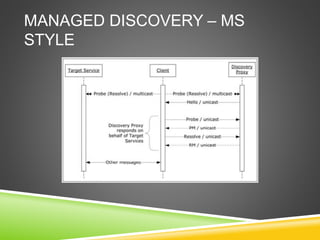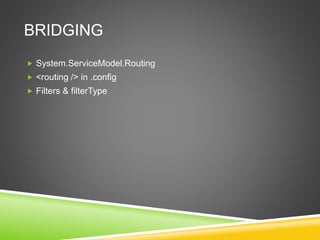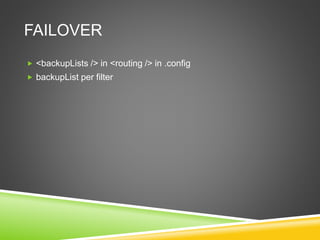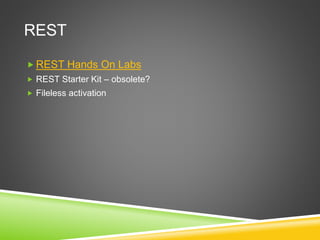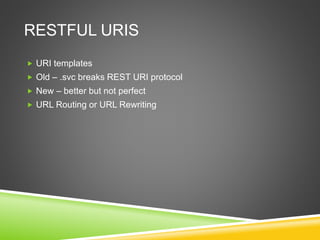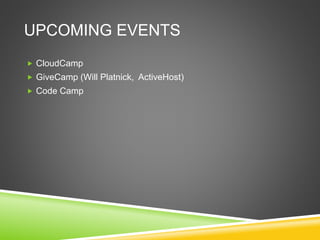WCF in .NET 4.0 - TVUG November 2010
- 1. WCF: ITâS BAAACK Tech Valley .NET User Group November 2010 Andy Badera andrew@badera.us Client Services, Apprenda, Inc. WCF in .NET 4.0 Discovery, failover, bridging & REST
- 2. AGENDA ï Review ï Whatâs New ï Discovery ï Tracing ï Break ï Failover (routing) ï Protocol bridging (routing) ï REST ï Q&A
- 3. APPRENDA & SAASGRID ï VC-backed ($6.5M) startup in Clifton Park â hiring! ï Scalable SaaS-enablement platform & WCF grid for .NET ï Transform single tenant apps -> multitenant ï We reduce your time to market/revenue ï Heavy manipulation of WCF configuration ï Inject endpoints for grid awareness/participation ï Inject behaviors for session management and tenancy/subscription enforcement
- 4. ABCâS OF WCF ï Address ï Binding ï Contract
- 5. HOSTING WCF ï IIS (HTTP/S) ï Within a WCF application (WinForms, WCF; P2P, rich clients) ï Hosted by a Windows service ï WAS (non-HTTP via IIS model) ï AppFabric
- 6. WCF DEVELOPMENT/DEBUGGING ï C:Program Files (x86)Microsoft Visual Studio 10.0Common7IDE ï WcfTestClient ï C:Program FilesMicrosoft SDKsWindowsv7.1Bin ï SvcUtil â proxy autogenerator â âAdd Service Referenceâ ï SvcConfigEditor â âWCF Service Configuration Editorâ ï SvcTraceViewer
- 7. WHATâS NEW IN 4.0 ï VS2010 Training Kit labs ï Zero-configuration services ï Default behaviors & bindings ï Fileless activation (IIS/WAS) ï Standard endpoints
- 8. WHATâS NEW IN 4.0 ï Discovery (WS-Discovery) http://docs.oasis-open.org/ws-dd/discovery/1.1/wsdd-discovery- 1.1-spec.html ï Routing ï Failover ï Protocol bridging
- 9. STANDARD ENDPOINTS ï Well-known infrastructure & application service types ï Designated by âkindâ attribute ï Specify no binding, no contract â well-known
- 10. DEFAULTS ï Default behavior - unnamed behavior ï Default binding â protocol mappings
- 12. DISCOVERY â WINDOWS RALLY
- 13. AD HOC DISCOVERY - UDP ï System.ServiceModel.Discovery ï Sync or Async ï Broadcasts announcements ï Well-known standard endpoints â UdpDiscoveryEndpoint, UdpAnnouncementEndpoint ï Filtered by various criteria ï Metadata â System.ServiceModel.Description
- 14. AD HOC DISCOVERY - UDP
- 15. TRACING ï WCF trace logs ï Network (netmon, Wireshark)
- 18. MANAGED DISCOVERY â MS STYLE
- 19. BRIDGING ï System.ServiceModel.Routing ï <routing /> in .config ï Filters & filterType
- 20. FAILOVER ï <backupLists /> in <routing /> in .config ï backupList per filter
- 21. REST ï REST Hands On Labs ï REST Starter Kit â obsolete? ï Fileless activation
- 22. RESTFUL URIS ï URI templates ï Old â .svc breaks REST URI protocol ï New â better but not perfect ï URL Routing or URL Rewriting
- 23. Q&A
- 24. UPCOMING EVENTS ï CloudCamp ï GiveCamp (Will Platnick, ActiveHost) ï Code Camp
Editor's Notes
- #2: Who here has heard of WCF? Who here has used WCF? XML webservices? Who can tell me what SOAP stands for? Who has used RESTful webservices? Who can tell me what REST stands for?
- #5: ABCs define an âendpointâ â at a minimum the URI, port and binding of a service. Address is the URL and port. Binding is the transport protocol: http, https, net.tcp, etc. Contract is the contract, or interface, of the service being consumed.
- #6: IIS â ASP.NET-hosted .svc files; fileless activation WAS â message-based activation (RESTful URLs; MVC?) Show self-hosting/service hosting? Show WCF as ASMX trick? Show .svc consumed by plain web/AJAX clients (AspNetCompatibility)
- #7: YMMV on paths. Enable metadata on previous configuration-less example. Browse by web. Create WcfTestClient client, invoke. Disable metadata. Browse by web. Invoke by client. One of the trickier things with WCF, especially pre-4.0, is the complexity of configuration files. SvcConfigEditor makes it fairly simple to validate services, clients, behaviors & etc. as you add them through a GUI.
- #8: Show 3.5 config. Show configuration-less .svc deployment in 4.0.
- #10: i.e. Mex is always IMetadataExchange Mex EndpointA standard endpoint that is used to expose service metadata. AnnouncementEndpointA standard endpoint that is used by services to send announcement messages. DiscoveryEndpointA standard endpoint that is used by services to send discovery messages. UdpDiscoveryEndpointA standard endpoint that is pre-configured for discovery operations over a UDP multicast binding. UdpAnnouncementEndpointA standard endpoint that is used by services to send announcement messages over a UDP binding. DynamicEndpointA standard endpoint that uses WS-Discovery to find the endpoint address dynamically at runtime. ServiceMetadataEndpointA standard endpoint for metadata exchange. WebHttpEndpointA standard endpoint with aĖýWebHttpBindingĖýbinding that automatically adds theĖýWebHttpBehaviorĖýbehavior WebScriptEndpointA standard endpoint with aĖýWebHttpBindingĖýbinding that automatically adds theĖýWebScriptEnablingBehaviorĖýbehavior. WebServiceEndpointA standard endpoint with aĖýWebHttpBindingĖýbinding. WorkflowControlEndpointA standard endpoint that enables you to call control operations on workflow instances. WorkflowHostingEndpointA standard endpoint that supports workflow creation and bookmark resumption.
- #11: Is everyone familiar with WCF endpoint behaviors? Allows control of exception detail in error responses, service metadata, service discovery, timeouts, packet size and throttling for services and clients, myriad other facets of client and service behaviors. Default behavior applies to any defined service that does not explicitly specify another behavior. Note: the configuration editor tool from the SDK does not appear to like empty name or null name values. Default protocol mapping order is defined machine.config; can be overridden in machine.config, app.config, web.config. Default order in machine.config begins with basicHttp.
- #12: All SOAP â all metadata is XML, found throughout the messaging actions.
- #14: Discovery criteria include contract types, binding elements, namespace, scope, and keywords or version numbers
- #15: To find a service, clients send aĖýProbeĖýrequest that contains specific criteria such as service contract type, keywords, and scope on the network. Services receive theĖýProbeĖýrequest and determine whether they match the criteria. If a service matches, it responds by sending aProbeMatchĖýmessage back to the client with the information necessary to contact the service. Clients can also sendĖýResolveĖýrequests that allow them to find services that may have changed their endpoint address. Matching services respond toĖýResolveĖýrequests by sending aĖýResolveMatchĖýmessage back to the client. Work through Exercises 4-6; show next slide â Tracing â while work-in-progress.
- #16: Show trace(s) on UDP discovery while working through Exercises 4-6.
- #17: Utilizes a discovery proxy (dp). Ad hoc and managed will exhibit different network traffic behaviors, so one or the other may be more appropriate or provide better results in various scenarios. (P2P vs. client-server with failover, etc.) Up to the developer to understand the needs of their system; network profiling is a good tool.
- #19: Work through Exercise 7.
- #20: Generic, configurable SOAP intermediary. Updatable router config without service restart. Content-based XPath-driven routing. Do Exercise 8. Note â name âRouterServiceâ needs to be âCalculatorServiceâ for client to call the router service. Comment out net.tcp endpoint.
- #21: Talk about failover Do Exercise 10. Show service, network? traces from failover
- #22: Demo fileless activation
- #23: Do REST Lab 1. Do REST Lab 2. Show WCF REST Service Template using routes instead of URL Rewrite.

